
While visiting the Philippines these are the foods you simply must try. You can find most of these particular dishes throughout the country, although you may find some regional differences depending on the available ingredients found in different pockets of the country. Filipino food has subtle influences from its Asian neighbours but is actually among the most unique cuisines in the world, perhaps owing to the fact it’s a collection of islands, cut off from continental Asia. From traditional chicken stew to duck embryos and plenty in between, you can enjoy some culinary adventures in the Philippines no matter how brave you are when it comes to exotic cuisine.
1. BALUT

Most first-time visitors to the Philippines will find themselves challenged by the locals into eating one of the country's best known exotic delicacy, balut. It's basically a boiled egg with a semi-developed duck embryo aged between 16 to 21 days. The older it is, the more developed the embryo so you can expect to see the chick's feathers, beak, or claws. We guarantee it tastes better than it sounds though. Eating balut is more like a mind game. You're not supposed to stare too much or pick it apart. Just eat it! Crack a hole on the rounded end, slurp the juice inside, dash some salt or vinegar in, and pop everything in your mouth except the hard, white part. The juice tastes like a gamey chicken soup and the yolk is creamier than your usual boiled egg.
2. LECHON
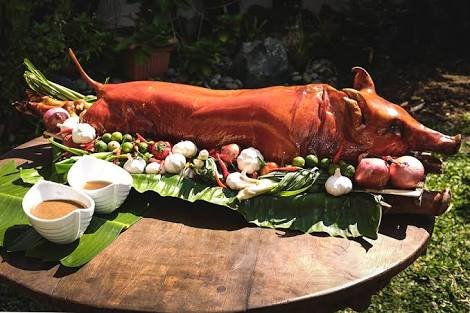
You will find lechon or spit-roasted pig in every town fiesta and major celebrations in a Filipino home. It is usually prepared by stuffing the pig with herbs and spices such as lemongrass, onions, and garlic and then slowly roasted over charcoal for hours until the skin turns reddish brown. The lechon's crispy and crunchy skin, as well as the moist and tender meat, has enamored locals and foreign visitors alike. In fact, even the famous American chef, Anthony Bourdain, can't help but exclaim after taking a succulent bite: "it's the best pig ever!". The best places to find lechon in the Philippines are in Manila and Cebu although you can pretty much find it everywhere. The difference mostly lies in the stuffing, the roasting style, length of time, as well as the type of pig used.
3. SINIGANG
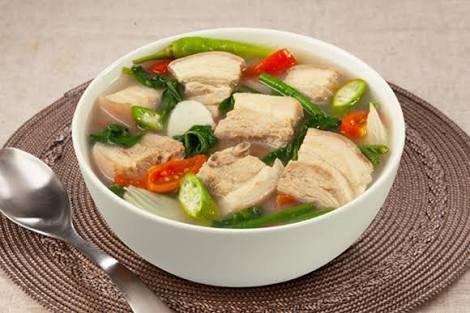
Sinigang is another all-time Filipino favourite. When we are feasting on grilled meat or seafood, locals prefer to have a soup or stew on hand to balance things out, and this soup is more often than not the humble sinigang. The primary ingredient would be pork along with a slew of vegetables like radish, taro, eggplant, string beans, tomato, and onion. Alternatively, beef, shrimp, fish or chicken is used instead of pork. As a souring agent, tamarind is the usual choice although some people use guava, santol, tomato, or kamias. Personally, we prefer our sinigang soup thicker and creamier so we like the version with more gabi or taro.
4. ADOBO
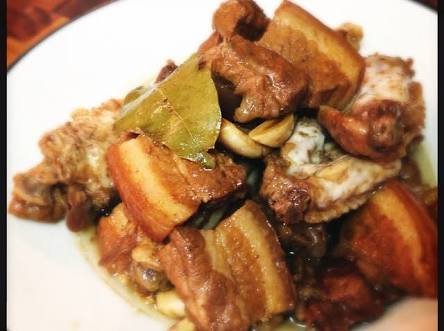
Another ubiquitous Filipino dish is the adobo which is essentially pork cooked in vinegar, soy sauce, garlic, bay leaf, and black peppercorns. Sometimes, eggs and potatoes are added but it is best paired with a steaming hot cup of rice. If you ask any Filipino to name a national dish, they would most likely say adobo. Every household has their own interpretation adding ingredients such as coconut milk and turmeric to suit their regional palate. Besides pork, some people prefer to use chicken. Either way, the meat is usually very tender and is just bursting with flavour. If you ask any foreigners what Filipino food they remembered and liked the most, they usually mention pork or chicken adobo.
5. SIZZLING PORK SISIG
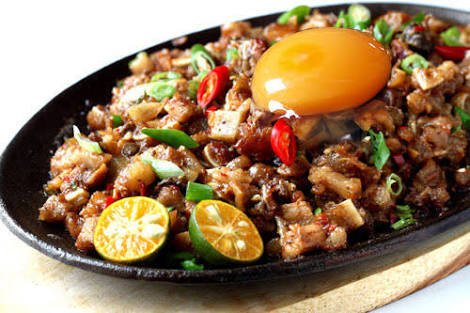
Sizzling Pork Sisig is another well-loved Filipino recipe, a staple pulutan or appetiser when the locals gather around to drink alcohol. Originating from the culinary capital of the Philippines, Pampanga, it was originally made with grilled pig's face and ears mixed with cooked liver, chili peppers, chopped onions, liver paste, topped with an optional egg and served on a sizzling metal plate. Over the years, the dish has been reinvented in other regions and we now have variants like the tuna sisig, crocodile sisig, and bangus (milkfish) sisig. While it is now considered as a popular entrée, consume it like the locals and have an ice-cold beer handy. Another interesting trivia, Chef Anthony Bourdain also predicted that this dish "will be the next big food trend in America".
6. BICOL EXPRESS
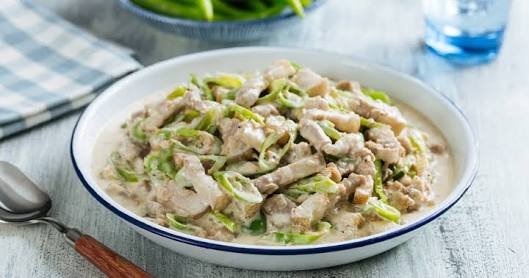
If you like hot and spicy food, you'll get hooked with Bicol Express. It is a spicy pork stew cooked with coconut milk, shrimp paste, and heaps of chili pepper. Believed to have originated from the Bicol region, it was actually named after a train that used to traverse the Manila to Bicol route. The first time I tried this dish, I was amazed by how tender the meat was and how creamy yet spicy it was. If you have a very low tolerance towards spicy food, this might put you off. But we like spicy food and we love it so much that we ordered some for takeout and brought it with us on the domestic flight home.
7. TINOLANG MANOK
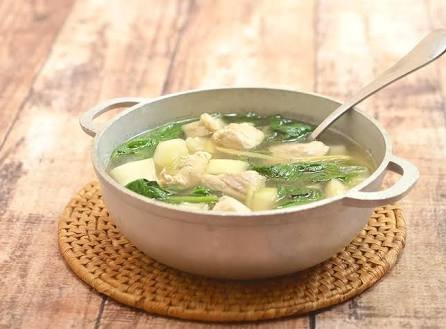
Tinolang Manok is the ultimate comfort food for many Filipinos. In fact, it has become synonymous with "home" and a sip of its tasty broth automatically makes one nostalgic. It's a chicken stew cooked with green papaya and chili leaves and flavoured with onion, ginger, and fish sauce. Some variants make use of the very nutritious malunggay or moringa leaves. Either way, the best tinolang manok is the one that makes use of native chicken. It's a very common meal in the Philippines especially in the provinces because the locals can simply catch one of their chickens in the backyard and harvest their own papaya and chili leaves and voila! They have a very tasty chicken soup for lunch or dinner. If you want to have a taste of Filipino home cooking, you can't get any better than this.
Read more at: http://www.philippines-hotels.ws/dining/food.htm?cid=ch:OTH:001
Hi! I am a robot. I just upvoted you! I found similar content that readers might be interested in:
http://www.philippines-hotels.ws/dining/food.htm